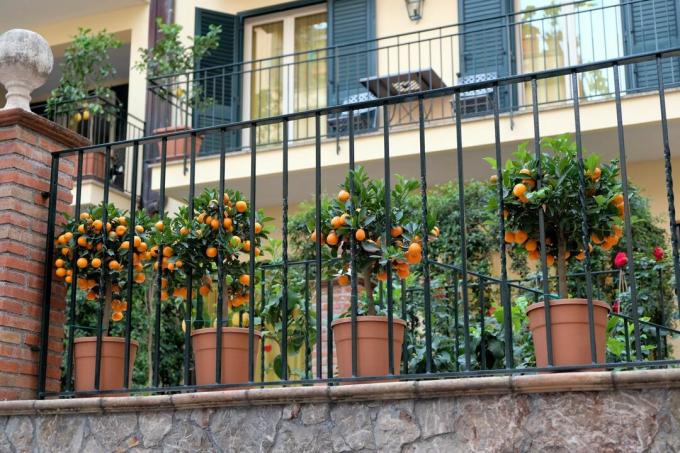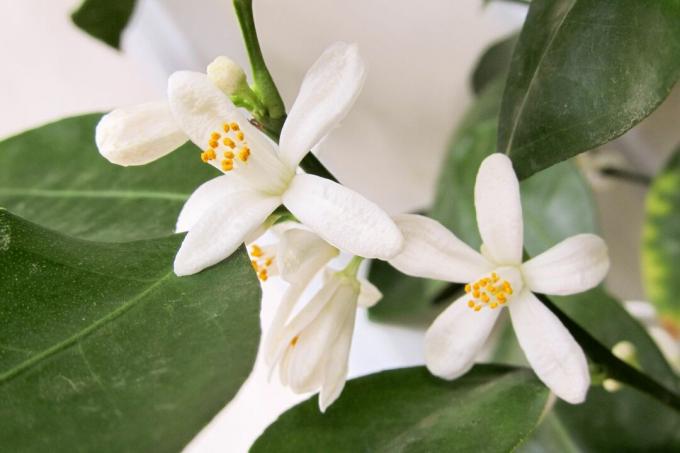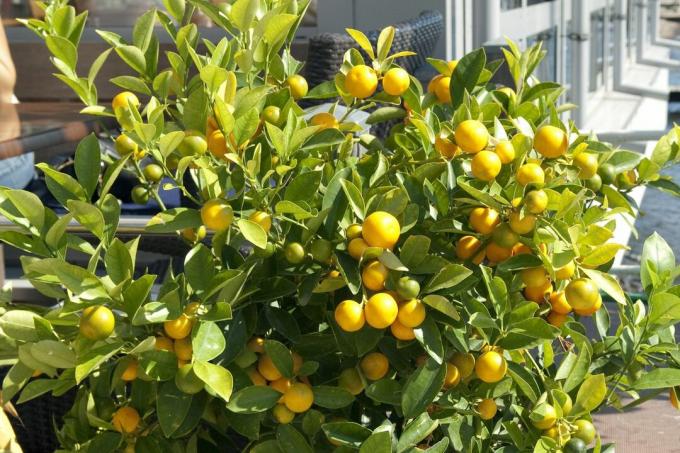Since citrus plants come from warmer regions, caring for them in this country is not easy. With the slightly smaller but easy-care calamondin orange, beginners can immerse themselves in the world of citrus fruits.

The small-fruited calamondin orange tree (Citrofortunella microcarpa) delights gardeners with its ornamental fruits. These develop in large numbers on the plant and can then be harvested. The tree is kept as a pot or tub plant that spends the summer on the sunny terrace or balcony. It is also suitable as a houseplant.
contents
- Calamondin: origin and properties
- Planting calamansi: location and procedure
-
Proper care of calamondin
- Cut calamondin
- Water and fertilize
- repot
- Calamondin loses leaves: what to do?
- Overwinter calamondin
- Harvesting and Use: Is the calamondin edible?
Calamondin: origin and properties
The calamondin orange, also known as calamansi or under the botanically obsolete terms Citrus mitis
and Citrus madurensis known, is a natural cross between the tangerine (Citrus reticulata) and a kumquat species (Fortunella sp.). The calamondin orange tree is particularly widespread in East Asian and Caribbean areas, where the fruits are increasingly cultivated. Since the small calamondin oranges are completely edible and have a very sour taste of their own, the fruits become For example, in Filipino or Malaysian cuisine, it is often used to make spices, jams, vinegar or lemonade used. The plant grows as an evergreen perennial tree and has lanceolate to ovate leaves. In its homeland, the calamondin tree grows up to 8 m tall, while in Germany it only reaches a size of almost 2 m when kept in a bucket.
Planting calamansi: location and procedure
Unfortunately, since the Calamansi orange comes from warmer areas, it cannot be planted directly outdoors in our latitudes. Instead, it must be kept as a container plant and overwintered or placed in a heated greenhouse or conservatory. Like most citrus plants, the calamondin orange prefers a very sunny location. If the plant does not get enough sunlight, especially during the winter, additional exposure to plant lamps can be of great benefit. For example, if the calamondin tree is in a bright south-facing window, no additional lighting is required. With enough light, the calamansi can be kept as a houseplant all year round, but it's over better to keep the plant outdoors in a sunny spot during the summer months place. A slightly acidic, permeable soil is suitable as a substrate, since the calamondin tree does not tolerate waterlogging. A blend of our peat-free Plantura organic universal soil with an admixture of about one third of sand or other mineral granules for example a structurally stable composition, which is important for densification of the substrate to avoid.

Plantura organic universal soil
Organic, peat-free & climate-friendly:
For all plants indoors & outdoors,
100% natural ingredients,
harmless to humans and animals
At a glance: planting calamondin
- Pot: Significantly larger and with a drainage hole
- Fill in a drainage layer at the bottom, for example made of gravel, expanded clay, potsherds
- Prepare substrate mix: Nutrient-rich, slightly acidic potting soil and 30% structural material such as expanded clay
- Fill in some substrate, insert calamondin, fill in at the edge and press down
- Cover the root ball only thinly with a layer of soil, do not plant too deep
- casting
- Apply a layer of mulch

Proper care of calamondin
When caring for the calamansi, a few points should be observed so that the citrus plant grows healthily.
Cut calamondin
Regular pruning is necessary to keep the calamondin tree in shape and healthy. However, since the plant grows quite slowly, this maintenance cut is not necessary very often. The best time to do this is spring just before new growth, ideally just before repotting. With a sharp and clean tool, remove all diseased, crossing and inward branches at the base. Twigs that are too long are shortened with a slightly oblique cut above an outward-pointing bud. Since the calamansi always flowers on the tips of the branches, it is advisable to trim it regularly to stimulate growth and branching and thus ensure rich fruit production. However, not too many branches should be cut in order to leave some flower buds for the coming bloom.

Water and fertilize
Depending on the pot size, season, soil used and location, there is of course a different watering rhythm. It is best to feel how dry or moist the substrate is with a finger in the ground. In general, the Calamansi gets by with a little less water, but should never stand in completely dry soil. Daily watering can therefore also make sense on hot and sunny summer days, but in winter it is almost never watered.
In addition to the correct watering of the citrus plant, it should be added that limy watering is unfavorable because the plant likes it slightly acidic. Therefore, in areas with particularly hard tap water, rainwater should be used or the water should be decalcified with appropriate filters.
In order to provide the calamondin tree and its fruits with sufficient nutrients for healthy growth, a special fertilizer for citrus plants, such as ours, is suitable Plantura Organic Citrus & Mediterranean Fertilizer. The liquid fertilizer is easy to use because it is simply mixed with the irrigation water. In addition, with the organic certification of our liquid fertilizer, you can help make hobby gardening more sustainable and environmentally friendly.

Plantura Organic Citrus & Mediterranean Fertilizer
Highly effective organic liquid fertilizer
with an NK ratio of 4-5
for all citrus and Mediterranean plants,
safe for pets and garden animals
Tip: Many liquid fertilizers are phosphate-reduced to protect global phosphorus reserves. So does ours Plantura Organic Citrus & Mediterranean Fertilizer. If citrus plants are cultivated in the same substrate for many years, a phosphate deficiency can occur under certain circumstances. To prevent this, we recommend using a primarily organic complete fertilizer like ours once a year in addition to liquid fertilization Plantura organic flower fertilizer spread under the mulch. This need-based fertilization does justice to the plant and to environmental protection.

repot
In order to enable the calamondin orange to grow healthily, it must be planted in a species-appropriate manner and repotted from time to time. Due to its slow growth, the calamondin orange only needs to be repotted every 3 to 4 years, provided a sufficiently large pot and a structurally stable substrate have been chosen. At the latest when the whole planter has been firmly rooted, it is time to repot. Choose spring as the time, just before new growth. Remember to apply mulch to the root disc again after repotting.
Calamondin loses leaves: what to do?
If the calamansi orange loses leaves, there are various reasons for this:
- Location too dark: If the calamondin has too little light, leaves that are turned away from the sun can fall off, so the plant should be placed as brightly as possible and rotated occasionally.
- nutrient deficiency: If the supply of nutrients is insufficient, the calamondin tree can turn yellow and then lose leaves, which is why regular repotting and fertilizing are extremely important.
- Lack of water or waterlogging: If the plant is watered too much or too little, leaves can also fall off, so the moisture in the substrate must be checked regularly.
- Wrong wintering: Too little light or too much water can have a bad effect on the plant, especially during the winter. Read more about hibernation below.
- Diseases and Harms: Other causes are diseases and pests. Spider mites are common, especially in dry summers, but also in winter. Scale insects are often found especially during the winter in the house. Therefore, the Calamansi should be examined at certain intervals. If you discover diseased or infested shoots, they should be removed or with appropriate plant protection measures, such as our Plantura Pest Free Neem, be treated. This oil offers protection against aphids, thrips and many other harmful insects and is kind to bees and beneficial insects when used correctly.

Overwinter calamondin
Because the calamondin orange tree is not hardy, it must be kept away from sub-zero temperatures. It is best to overwinter the calamansi bright and cool. A temperature of 5 to 10 °C would be ideal for this, but the plant can even be overwintered at room temperature. It is important to ensure that the plant is then as bright as possible.
For more details on hibernation, see our article on Hibernation of citrus plants.

Harvesting and Use: Is the calamondin edible?
The fruits are bright orange in color when ripe and edible with the skin, which has little effect on the taste. In general, the calamansi fruit is quite sour when eaten, but is well suited for Production of calamondin jam or other products, such as syrup or others Drinks. The fruit is also an excellent condiment. The juice is ideal for marinating poultry or fish. Furthermore, the calamansi is often processed into a gel in the star kitchen, which is used to garnish a wide variety of dishes.

The citrus fruit calamondin can actually be harvested all year round, but most of the fruits naturally ripen in summer. Thus, between July and September, most Calamansi oranges can be enjoyed fresh from the tree and are not only visually pleasing, but also culinary.
At best, the fruits are removed together with the fruit stalk when harvesting. Use sharp, clean scissors for this. If you simply pick the small oranges from the tree, peel residues sometimes get stuck, which can then have negative effects on plant health.
The calamondin tree has a similar climate preference nectarine. In contrast to calamansi, however, it can be planted directly in the garden in suitable locations.
...and receive concentrated plant knowledge and inspiration directly in your e-mail inbox every Sunday!



